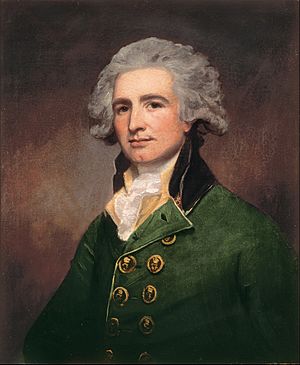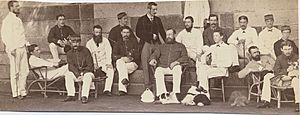75th (Stirlingshire) Regiment of Foot facts for kids
Quick facts for kids 75th (Stirlingshire) Regiment of Foot |
|
|---|---|
| Active | 1787–1881 |
| Country | |
| Branch | |
| Type | Infantry |
| Size | One battalion |
| Garrison/HQ | Dorchester Barracks |
| Engagements | Third Anglo-Mysore War Fourth Anglo-Mysore War Second Anglo-Maratha War Napoleonic Wars Indian Rebellion |
The 75th (Stirlingshire) Regiment of Foot was a special group of soldiers in the British Army. They were a "line infantry" regiment, which means they fought in lines on the battlefield. This regiment was started in 1787. Later, in 1881, it joined with another regiment, the 92nd (Gordon Highlanders) Regiment of Foot, to become a new, bigger group called the Gordon Highlanders. This change happened because of something called the Childers Reforms, which reorganized the British Army.
Contents
History of the Regiment
How the Regiment Started

The 75th Regiment was first formed in Stirling, Scotland, in October 1787. It was created by Colonel Robert Abercromby. The main reason for forming this regiment was for them to serve in India. At first, it was called the 75th (Highland) Regiment of Foot.
The regiment was fully ready by June 1788. Soon after, they traveled to England and then sailed to India, arriving there by the end of the year.
Fighting in India
The 75th Regiment saw a lot of action in India. They were involved in the siege of Seringapatam in February 1792. This was during the Third Anglo-Mysore War.
They also fought in the Battle of Seedaseer in March 1799. Then, they were part of the attack force at the siege of Seringapatam in April 1799. These battles were part of the Fourth Anglo-Mysore War.
The regiment also took part in the siege of Bharatpur in January 1805. This happened during the Second Anglo-Maratha War. After all these battles, the regiment returned home to Britain in August 1806.
When they got back, they had trouble finding enough new soldiers from the Highlands. Because of this, they lost their "Highland" status. In April 1809, their name changed to simply the 75th Regiment of Foot.
Napoleonic Wars Era
In June 1811, the regiment moved to Jersey, an island near France. Later, in October 1811, they were sent to Messina in Sicily. At this time, there were political problems in Sicily.
A British leader named Lord William Bentinck helped create a new government for Sicily. This new government gave Sicilians more freedom than before. The 75th Regiment was part of a British-Sicilian force led by Bentinck. They carried out a raid on the coast of Calabria in February 1813.
The regiment then moved to the Ionian Islands in July 1814. In 1821, they went to Gibraltar. Finally, they returned to England in 1823.
The Victorian Era Battles

In 1830, the regiment sailed to the Cape Colony in South Africa. There, they fought in the Sixth Xhosa War in December 1834. They returned to Britain in 1843.
In 1849, the regiment went back to India. They played a very important role in the Indian Rebellion (also known as the Indian Mutiny). In June 1857, they were part of the first attack group at the siege of Delhi. They bravely led a bayonet charge during this siege.
The regiment also fought at the siege of Lucknow in November 1857. They were even part of the funeral ceremony for Major-General Sir Henry Havelock that same month. Later, in March 1858, they helped capture Lucknow.
The 75th Regiment returned home to Britain in 1862. In November 1862, their name changed again to the 75th (Stirlingshire) Regiment of Foot.
They were sent to Gibraltar again in 1867. Then, they moved to Hong Kong in 1868 and to Singapore in 1869. After that, they returned to the Cape Colony in 1870. Their final return home was in 1875.
The End of the Regiment
In the 1870s, the British Army went through changes called the Cardwell Reforms. These reforms linked smaller regiments together. The 75th Regiment was linked with the 39th (Dorsetshire) Regiment of Foot. They shared a main base and recruiting area at Dorchester Barracks in Dorchester.
On July 1, 1881, even bigger changes happened with the Childers Reforms. The 75th Regiment officially joined with the 92nd (Gordon Highlanders) Regiment of Foot. Together, they became the 1st battalion of the new Gordon Highlanders regiment. This meant the 75th Regiment of Foot no longer existed as a separate unit.
Battle Honours
These are some of the special "battle honours" the regiment earned for their bravery in important battles:
- Fourth Anglo-Mysore War: Seringapatam, India
- Indian Mutiny: Delhi 1857, Lucknow
Victoria Cross Recipients
The Victoria Cross is the highest award for bravery in the British military. These soldiers from the 75th Regiment received it:
- Colour Sergeant Cornelius Coughlan, during the Indian Mutiny (June 8, 1857)
- Private Patrick Green, during the Indian Mutiny (September 11, 1857)
- Lieutenant Richard Wadeson, during the Indian Mutiny (July 17, 1857)
Images for kids
-
The siege of Bharatpur in January 1805.




